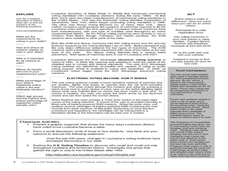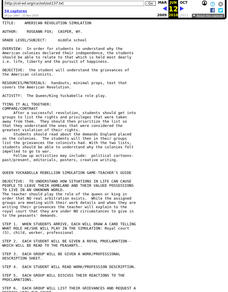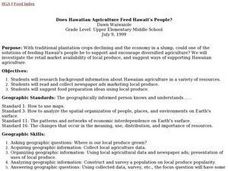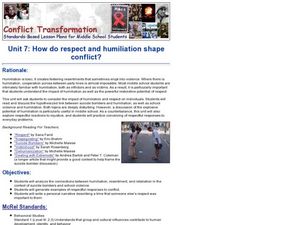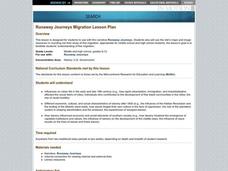Curated OER
How We Vote
Students fill in a graphic organizer and discuss the struggles in groups about the history of voting in Louisiana. Students also explore a voting timeline to see who could and could not vote before and after 1850.
Curated OER
Using Word Processing to Create Graphic Organizers
Students create a graphic organizer and instructional rubric using word processing software. They conduct Internet research at the History Alive website, and publish an essay.
Curated OER
American Revolution Simulation: Colonial History, Drama
Learners explain why the American colonies declared the independence, students should relate to that which is held most dearly i.e. life, liberty and the pursuit of happiness. They participate in a drama that illustrates this.
Curated OER
Around the World At 30o North Latitude
Reinforce the use of an atlas and reference materials with writers. They discover how geographic location can make living easier or harder. They draw an assigned journey on a map, categorize survival needs, and prioritize options during...
Curated OER
Does Hawaiian Agriculture Feed Hawaii's People?
Students research background information about Hawaiian agriculture in a variety of resources, then read and collect newspaper ads marketing local produce. They suggest food preparation ideas using local produce.
Curated OER
Sequencing of Events
Pupils pick a time period and put events in chronological order using symbols.
Curated OER
Reorganizing the Bill of Rights
Eighth graders, in groups, explore all 26 amendments and group them accordingly.
Curated OER
How an Idea Becomes a Law
Students explore how a bill becomes a law and the actions the President may take. They create a poster illustrating the steps.
Curated OER
The Influence of Physical Geography
Students explore the limits and demands of their physical world and how it relates to the survival and well-being of people.
Curated OER
A Sample of What?
Students are introduced to the connection between women and the textile industry. Using primary source documents, they complete a handout on how gender roles have changed over the years. They examine a sampler which is connected to the...
Curated OER
African American Life in the Nineteenth Century
Students read about the life and work of John and Mary Jones. Using primary source documents, they draw conclusions about their role in the abolistionist movement. They also examine artifacts from their lives and analyze their portrait...
Curated OER
John Jones and the Fight to Repeal the Black Laws
Students examine the role of John Jones and his fight to repeal the Black Laws of Illinois. Using the text of the law, they explore his reasoning for repealing the laws and the arguments he used to support his beliefs. They draw their...
Curated OER
Living Under the Illinois Black Codes
Students use the text of the Illinois Black Codes to examine the laws in place. Using this information, they draw their own conclusions about why the laws existed in a free state. They also identify the purpose of these laws and how they...
Curated OER
John and Mary Jones and the Importance of Oral History
Students examine the role of John and Mary Jones in the abolitionist movement. Using primary source documents, they discover the importance of an oral history and take notes on the Jones' role. They write a summary of the data to...
Curated OER
Freedom Fighters Throughout American History
Students use the internet to research people who have contributed to the cause of freedom. They identify examples of freedom which are important to them and categorize them. In groups, they create a timeline of the Freedom Fighters and...
Curated OER
The Civil War Through a Child's Eyes
Middle schoolers focus upon the Civil War era using research methods of drawing information from primary sources. Literature and photographic images reflect, communicate, and influence human perspectives of historical events. The lesson...
Curated OER
Comparing Cities and Their Common Functions
Ninth graders begin the lesson plan by watching a PowerPoint on the functions of cities. In groups, they use the internet to research various cultures throughout history and the cities that were formed at the time. They present their...
Curated OER
Entrepreneurship
Give your class a copy of USA TOday to read through and find articles about companies that offer goods or services. They create a graphic organizer and list the business, product, want or need fulfilled of the companies found in the USA...
Curated OER
Trade in the Ancient Mediterranean
Students begin the lesson by locating cities and other points of interest in the ancient world. In groups, they use the internet to research the types of ships used during this time period and discuss the reasons why trade was used. ...
Curated OER
Create Your Own Florida Murals
Students study a mural that represents life in Florida. They choose one portion of the mural and redraw it showing what the character in that portion would be doing next. (Is the person headed to the beach? Where the bird fly next? etc.)
Curated OER
How Do Respect and Humiliation Shape Conflict?
Young scholars explore the feelings surrounded by humiliation, resentment and retaliation in the context of school violence. In this character building lesson, students examine possible reasons for school violence and focus on possible...
Curated OER
RUNAWAY JOURNEYS MIGRATION
Students analyze the influences on urban life in the early and late 19th century, different economic, cultural, and social characteristics of slavery after 1800, the rise of racial hostility, and the ending of the Atlantic slave trade.
National First Ladies' Library
Michigan vs. Ohio State: A Serious Rivalry!
Middle schoolers discuss and research the pros and cons of school rivalries. In particular, they study the Michigan-Ohio State rivalry. Through their research, they think about how media accounts of college football games can be shaped...
Curated OER
Be the Kiwi: New Zealand Introductory Activity
Students get a taste of New Zealand. In this global studies lesson, students view photographs from the country and discuss its geographic location and features. Students then participate in a scavenger hunt based on facts about the nation.


